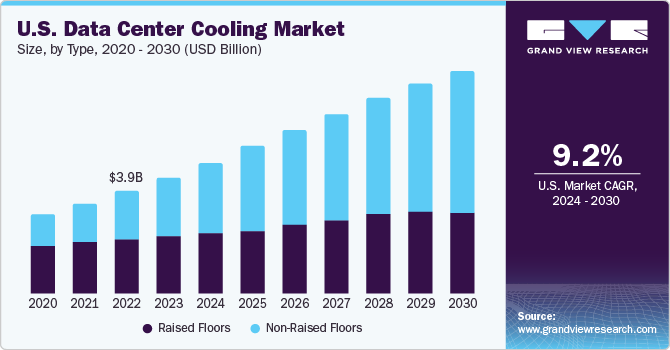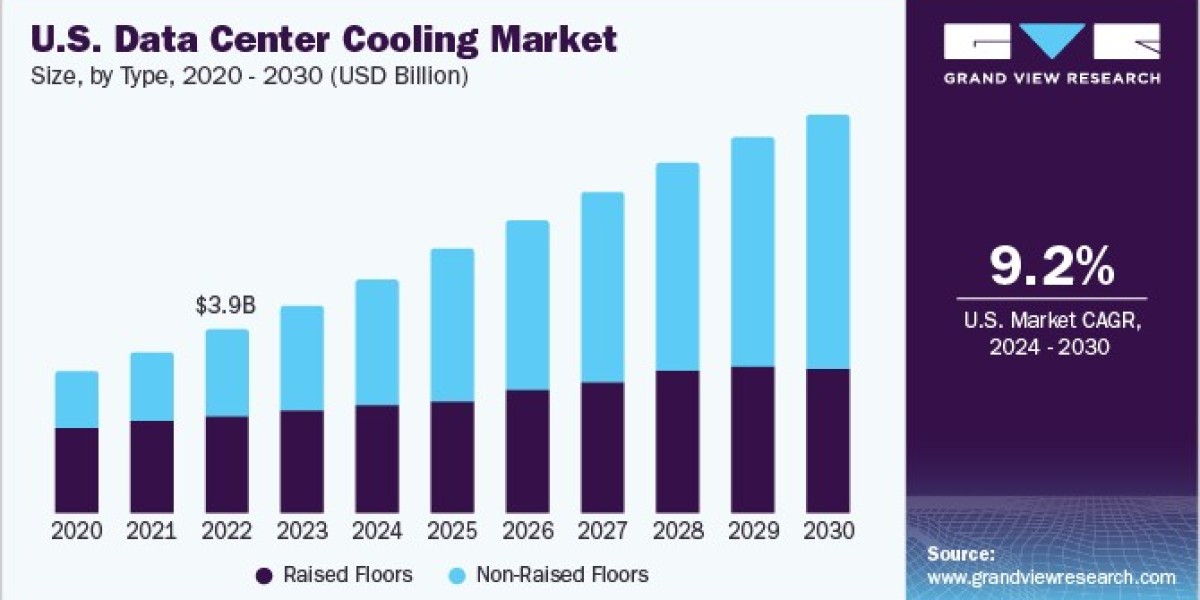Data Center Cooling Market Growth & Trends
The global data center cooling market size is expected to reach USD 56.15 billion by 2030, growing at a CAGR of 16.8% from 2024 to 2030, according to a study conducted by Grand View Research, Inc. The market is expected to witness substantial growth on account of the need for enhanced cooling techniques to negate the scorching heat due to rising global temperatures. An increasing number of data center facilities worldwide is fueling market growth. In addition, a gradual shift toward cloud services is creating a rise in demand for eco-friendly cooling technology. Favorable initiatives by governing bodies across the globe that are focused on promoting cloud proliferation are driving demand for data centers, subsequently developing the sense of direction for the data center cooling industry.
For instance, the United Arab Emirates (UAE) funded several projects related to cloud computing, such as Smart Abu Dhabi or Smart Dubai. These projects were aimed at bringing in rapid digital transformation among enterprises while backing countries' economic growth. Such initiatives by different governments across the globe are expected to augment the usage of data centers, thereby supporting the demand for cooling solutions. The solution component segment led the market in 2023. The integration of data center cooling solutions with modern technologies, such as IoT sensors, enables the real-time monitoring of environmental conditions. The incorporation of AI further improves the role of air conditioners.
Gather more insights about the market drivers, restrains and growth of the Data Center Cooling Market

AI algorithms can evaluate data trends, forecast heat loads, and alter cooling parameters continuously for optimal effectiveness. Smart controls enable proactive modifications, improving cooling performance and enhancing overall data center efficiency. However, data center expansion is often associated with high CO2 emissions and increased energy usage. Furthermore, these cooling solutions are estimated to account for 35% of the total energy consumption in data center facilities. Therefore, vendors in this space are focused on introducing sustainable cooling solutions while attempting to save over 70% of the cost associated with cooling. For example, Apple’s North Carolina data center facility functions on sustainable power sources, and data center cooling is attained through the free air cooling technique, allowing the chillers to be off almost 80% of the time.
In addition, there is growing pressure from local and federal government agencies, environmentalists, and the public on organizations to implement green initiatives. Hence, the increasing demand for eco-friendly and cost-effective cooling solutions is most likely to propel the industry growth.The precision air conditioners segment is expected to have the highest CAGR from 2024 to 2030. The global expansion of digital infrastructure, particularly in developing nations, is opening new avenues for the use of precision air conditioners. As data center operations expand globally, there is a growing need for accurate and effective cooling solutions. Precision air conditioners can address these demands and build a strong presence in emerging data center industries.
However, high maintenance and installation costs, carbon emissions, and electricity consumption are some of the challenges affecting the market growth. The market is consolidated and characterized by high competition. These global players focus on introducing different data center cooling techniques to strengthen their market presence. In May 2023, Vertiv Group Corp. unveiled a liquid cooling distribution unit. In air-cooled data centers, methods such as direct-to-chip liquid cooling can be implemented thanks to the Liebert XDU, which was introduced in the US in 2019. Europe, the Middle East, and Africa can now purchase it. Water efficiency and support for high-density data centers running analytics and machine learning applications are key architectural features of the XDU. There are two capacities available: 450kW and a variant with a maximum capacity of 1368kW.
Data Center Cooling Market Report Highlights
- The maintenance & service segment is anticipated to witness a significant CAGR from 2024 to 2030. This is due to innovation in areas like liquid cooling technologies and growing usage of direct-to-chip cooling techniques for better thermal management
- The non-raised floor segment will grow at the highest CAGR from 2024 to 2030. Non-raised floor plays a crucial role in integrating modern thermal assessment and surveillance systems. It provides real-time monitoring of temperature fluctuations across the data center, allowing service providers to identify and address any issues before they occur. Non-raised floor solutions help save costs in both data center construction and ongoing upkeep
- Based on containment, the raised floor with containment segment is expected to have the highest CAGR from 2024 to 2030. This segment is anticipated to witness the development of multi-modal containment systems. These systems can constantly modify confinement configurations based on workload fluctuations, allowing for effective airflow control in response to changing conditions
- The row-based cooling systems segment will register the highest CAGR from 2024 to 2030 due to advancements in circulation management. Advanced containment structures and procedures are being developed to improve the separation of hot & cold air within the data center. Row-based cooling is becoming more popular in hyperscale data centers. These solutions provide flexibility & effectiveness to large-scale institutions with considerable computer infrastructure
- The telecom segment is expected to have the highest CAGR from 2024 to 2030. 5G penetration and the pandemic that brought about a rapid need for digital transformation among enterprises are the key factors responsible for the segment’s growth
Browse more reports published by Grand View Research.
- Fencing Market Size, Share & Trends Analysis Report By Material, By Distribution Channel, By Installation, By Application (Residential, Agricultural, Industrial), By End-use, By Region, And Segment Forecasts, 2024 - 2030
- Fire Truck Market Size, Share & Trends Analysis Report By Application (Residential & Commercial, Enterprise & Airports, Military, Others), By Type (Tankers, Pumpers, Aerial Platform, Rescue, Others), By Region, And Segment Forecasts, 2023 - 2030
Data Center Cooling Market Segmentation
Grand View Research has segmented the global data center cooling market based on component, solution, services, type, containment, structure, application, and region:
Data Center Cooling Component Outlook (Revenue, USD Billion, 2018 - 2030)
- Solution
- Services
Data Center Cooling Solution Outlook (Revenue, USD Billion, 2018 - 2030)
- Air Conditioners
- Precision Air Conditioners
- Chillers
- Air Handling Units
- Others
Data Center Cooling Services Outlook (Revenue, USD Billion, 2018 - 2030)
- Installation & Deployment
- Support & Consulting
- Maintenance Services
Data Center Cooling Type Outlook (Revenue, USD Billion, 2018 - 2030)
- Raised Floors
- Non-Raised Floors
Data Center Cooling Containment Outlook (Revenue, USD Billion, 2018 - 2030)
- Raised Floor with Containment
- Hot Aisle Containment (HAC)
- Cold Aisle Containment (CAC)
- Raised Floor without Containment
Data Center Cooling Structure Outlook (Revenue, USD Billion, 2018 - 2030)
- Rack-based Cooling
- Row-based Cooling
- Room-based Cooling
Data Center Cooling Application Outlook (Revenue, USD Billion, 2018 - 2030)
- Telecom
- IT
- Retail
- Healthcare
- BFSI
- Energy
- Others
Data Center Cooling Regional Outlook (Revenue, USD Billion, 2018 - 2030)
- North America
- U.S.
- Canada
- Europe
- UK
- Germany
- France
- Asia Pacific
- India
- China
- Japan
- South Korea
- Australia
- Latin America
- Brazil
- Mexico
- Middle East & Africa (MEA)
- UAE
- Saudi Arabia
- South Africa
Order a free sample PDF of the Data Center Cooling Market Intelligence Study, published by Grand View Research.








